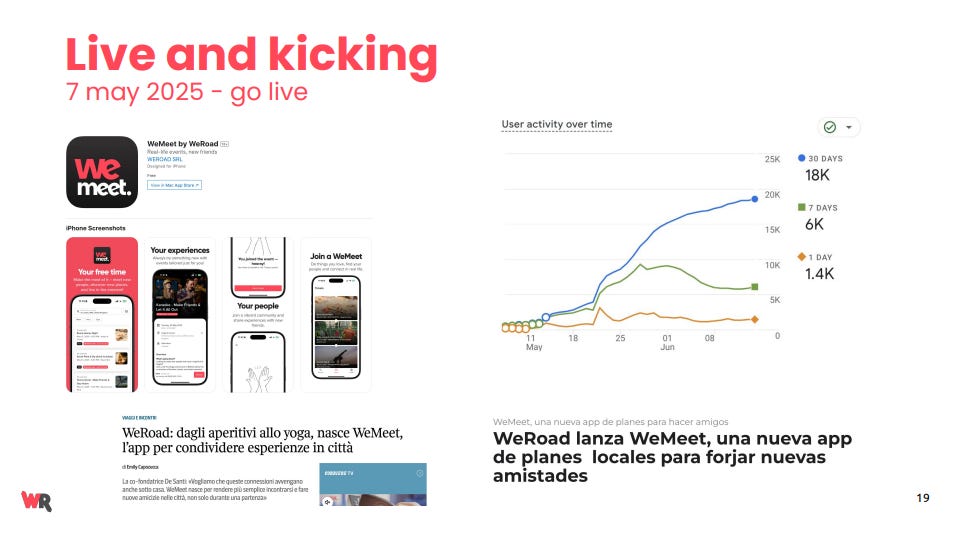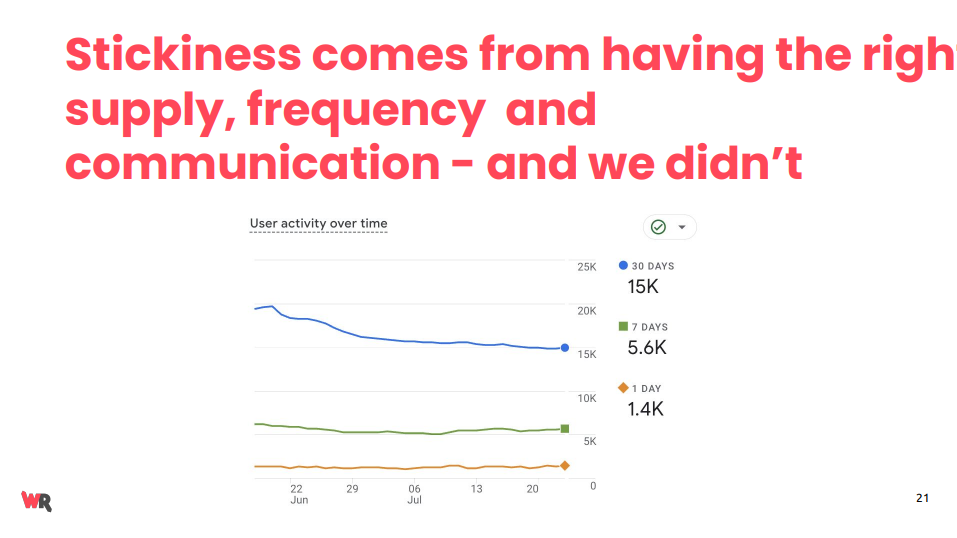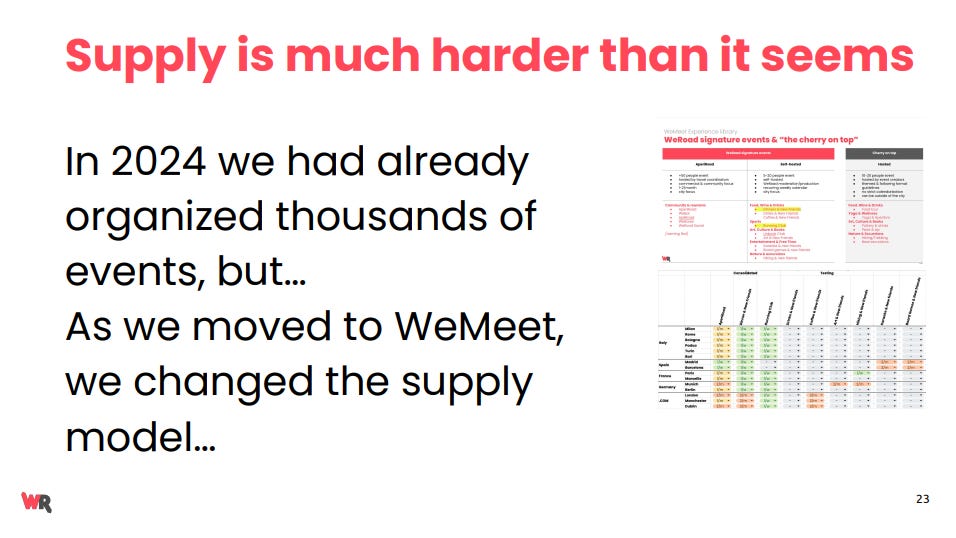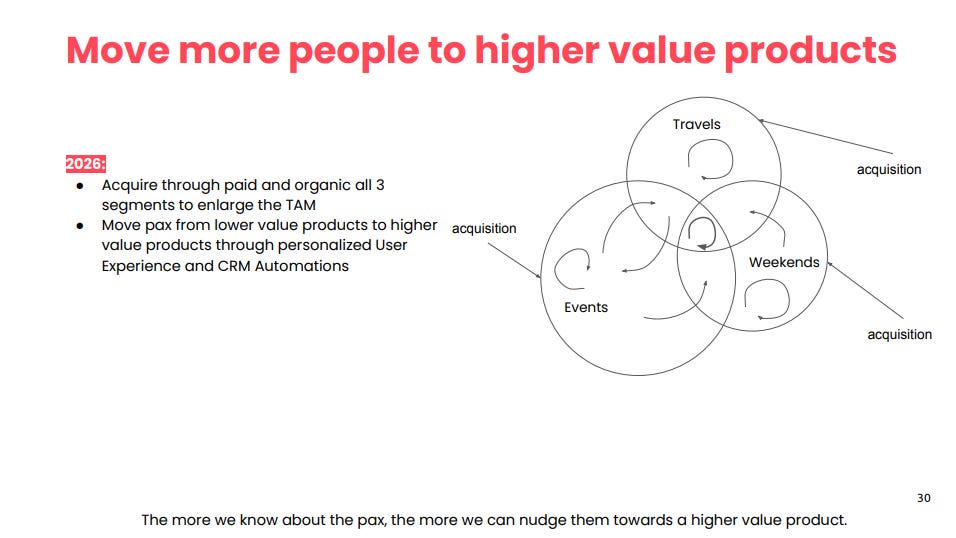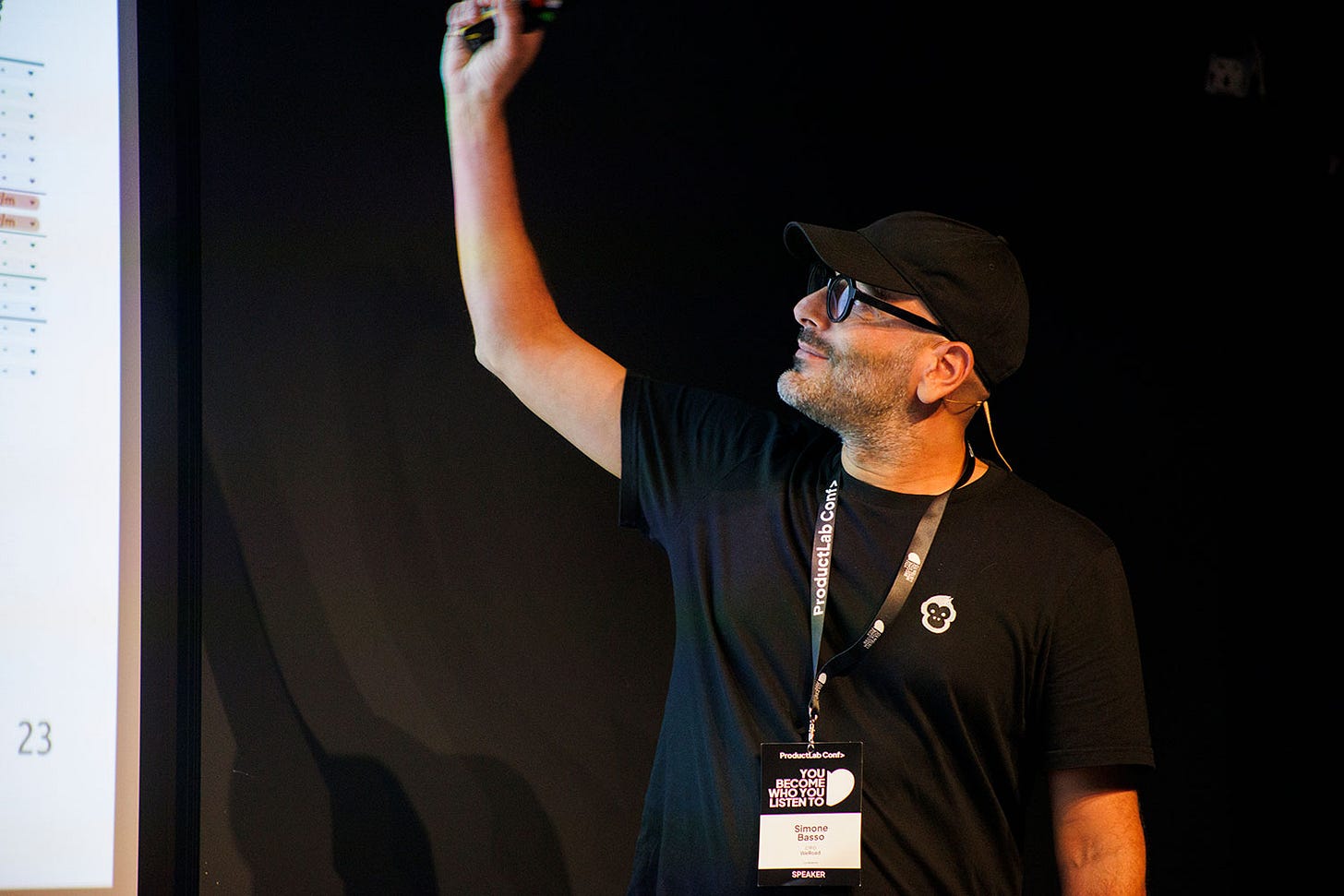How WeRoad Turned 1,200 Solo Travelers Into a Year-Round Community Movement
WeRoad had thousands of travelers who loved their trips. The problem? They only traveled twice a year. [Slides included]
When Simone Basso and the team launched WeRoad Events in 2024, they faced a problem most travel companies would kill for: they had thousands of customers who loved their group trips—but only traveled 1-2 times per year.
The Bet? Build a year-round community of local events across 18 European cities. Running clubs. Dinner with strangers. After-work drinks. In just one coordinated evening across Europe, they got 1,200 people to show up.
At ProductLab Conference 2025 in Berlin, Simone shared the brutal truth about building community products—the missteps, the data, and the principles that turned WeRoad Events from “a bit of a shit show” into a referral-generating growth engine.
“Speed of execution is much more important than perfection. We made a lot of errors on the way. It doesn’t really matter as long as you correct them super fast.”
— Simone Basso, CTPO at WeRoad
Understanding the Flywheel
WeRoad isn’t just a travel company where you book and go. It’s built on a community flywheel that most PMs miss.
Here’s how it works: Travelers join through social channels, do a weekend group trip with 15 strangers aged 25-49, then some become coordinators (paid guides who travel for free). These coordinators organize more events and trips, attracting more travelers.
In the center? A community of people passionate about solo travel and real-life connections.
The insight: 60% of people who book a trip join the Facebook group (Solo Travelers United) just before or after booking. They’re not just buying a trip—they’re buying into a community.
“Fundamentally, it is an evolution of dating apps. Tinder and the likes are all going down, but people do want in real life connections. Doing it in a group setting is much easier than in a dating setting.”
— Simone Basso
5 Principles for Building Community Products That Actually Scale
Simone distilled WeRoad’s journey into 5 hard-won principles. This isn’t theory—it’s what actually worked when they had to fix their “shit show.”
1. Ship Fast, Fix Faster—Perfection Is the Enemy
WeRoad launched their events app in 6 weeks. No monetization. No payment system. Just search, details, map, and RSVP.
They cut scope aggressively. Reused the design system from WeRoad. Focused only on what users absolutely needed to find and attend an event.
The result? They launched on time—but engagement dropped after the initial spike. Daily active users weren’t growing. Monthly active users weren’t growing.
“We made a lot of errors on the way. It does not really matter as long as you correct them super fast. It will be much worse to try and get everything perfect—the supply perfect, the message perfect. We would still be building.”
— Simone Basso
Action item: If you’re building a community product, launch your MVP in under 8 weeks. One core feature that works is better than three half-built features.
2. Clear Messaging Beats Clever Complexity
Their original landing page was a mess. QR codes on desktop. Unclear value prop. Too many event types across 30 cities in 5 countries.
Compare that to a competitor (Timeleft): “Stranger dinner Wednesday. Boom. Done.”
WeRoad’s fix? They narrowed to 3 event types: Running clubs, Dinners with new friends, We Work After Work. Same message across all 18 cities. One coordinated night across Europe.
The clarity unlocked growth. Last coordinated event: 1,200 attendees in one night.
Action item: If your product needs more than 10 words to explain, you’re confusing users. Cut your event types, your messaging, your supply—until a stranger gets it in 5 seconds.
3. Community Products Need Identity, Not Just Supply
WeRoad initially tried to be everything: bottom-up events, top-down organized dinners, 30 different cities, diverse event types from London to Bari.
It became “a completely unscalable problem.”
The mistake: treating WeRoad Events like WeRoad. But events aren’t trips—they’re a different market, different people, different identity.
“Having a clear identity and a clear supply is absolutely necessary to make it work and to grow our community. You cannot just pretend you’re good at WeRoad Events—it’s a completely different thing.”
— Simone Basso
Action item: Define your community’s identity in one sentence. If you can’t, your users definitely can’t.
4. Build for Repeat, Not Just Acquisition
The real metric that matters? Cohort retention by month.
21% of people who attend an event come back the next month. 8% come back two months later. About 20% become regular community members.
More revealing: 6-7% of event attendees had already done a WeRoad trip. 2% convert to become WeRoad customers after attending events.
The network effect is working. Events drive trips. Trips drive more events. Community drives both.
But here’s the gap: WeRoad doesn’t yet nudge people enough. Someone does a trip, makes friends—then those friends do a running club in Berlin next week. WeRoad should connect those dots.
Action item: Map your retention by cohort month-over-month. If 20%+ aren’t coming back, you don’t have community—you have transactions.
5. Own the Full Community Lifecycle
WeRoad replaced Meetup with their own platform. Next target? The Facebook group.
Why? They can’t control who people talk to, what they ask, or who responds. The pre-trip research phase—where fear and uncertainty kill conversions—happens entirely outside WeRoad’s control.
One clever solution they built: post-booking, travelers can share which flights they’ve booked. Other group members see it and coordinate to fly together. Small feature, massive reduction in “fear of traveling alone.”
“Getting ownership of the full cycle of the digital community is as important as making sure they have a great community experience. We’re never going to replace WhatsApp or Instagram for how people talk—but the upper funnel of community is crucial for growth.”
— Simone Basso
Action item: Audit where your community lives. If critical conversations happen off-platform, you’re blind to what drives or blocks conversions.
The Numbers That Matter
When asked about growth mechanics, Simone shared specific data:
900 referral friends in 4-5 months—almost €1 million in referred revenue.
The incentive structure: 5% discount immediately to the referred friend, 5% discount on your next trip (up to 50% off after 10 referrals).
But here’s the opportunity cost: they only talk about referrals to existing WeRoaders. They don’t nudge new customers pre-trip or post-trip enough.
“We don’t do enough nudging of new customers who could have other friends and bring them into the community even before they go on a trip.”
— Simone Basso
The user activity spike after refocusing the platform? It “fundamentally picked up”—exact numbers still climbing weeks after the messaging fix.
What WeRoad Got Wrong
Simone was brutally honest about their mistakes:
Mistake 1: They tried to stop paying coordinators to organize events, thinking community loyalty would sustain it. Coordinators refused. Supply collapsed.
Mistake 2: They spent weeks debating monetization—membership model vs. pay-per-use—before shipping the MVP. Premature strategy discussion that delayed value.
Mistake 3: They lost sight of the community during the platform migration. Changing the supply model and the platform simultaneously confused everyone.
“We had to rush to organize all these different types of events in 5 countries, 30 cities. From London to Berlin to Milan to Bari—very complicated. It became completely unscalable. We fundamentally screwed up.”
— Simone Basso
The fix came fast: focus on 3 event types, 18 cities, consistent messaging, and rebuilt relationships with coordinators.
The Conviction: Community Is the Moat
Simone’s bet is simple: community compounds.
Travelers who attend events repeat more. They book more trips. They stay engaged year-round instead of 1-2 weekends annually.
The next phase? Replace Facebook groups with their own platform. Control the pre-trip conversations where fear and uncertainty live.
Long-term vision: WeRoad becomes the platform where solo travelers discover trips, meet locals, attend events, and build friendships—all in one ecosystem.
“Running clubs are the new dating. People want in-real-life connections in group settings—it’s much easier than one-on-one dating.”
— Simone Basso
The timeline: by end of 2025, own the full digital community experience.
Your Move
Building community products isn’t magic. It’s discipline.
Simone and the WeRoad team proved that with the right framework—ship fast, clarify your identity, design for repeat, own the lifecycle—you can turn one-time travelers into year-round community members.
Start with one thing tomorrow: Cut your event types to 3 or fewer. Make them crystal clear. Then add coordinated launch days across all your locations.
The community product that wins isn’t the one with the most features. It’s the one people understand in 5 seconds and come back to every month.
Connect with Simone:
LinkedIn: Simone Basso
Medium: Simone Basso




